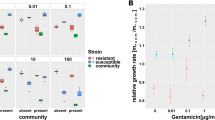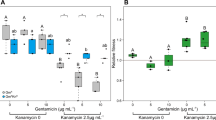Abstract
In structured environments, antibiotic-producing microorganisms can gain a selective advantage by inhibiting nearby competing species1. However, despite their genetic potential2,3, natural isolates often make only small amounts of antibiotics, and laboratory evolution can lead to loss rather than enhancement of antibiotic production4. Here, we show that, due to competition with antibiotic-resistant cheater cells, increased levels of antibiotic production can actually decrease the selective advantage to producers. Competing fluorescently labelled Escherichia coli colicin producers with non-producing resistant and sensitive strains on solid media, we found that although producer colonies can greatly benefit from the inhibition of nearby sensitive colonies, this benefit is shared with resistant colonies growing in their vicinity. A simple model, which accounts for such local competitive and inhibitory interactions, suggests that the advantage of producers varies non-monotonically with the amount of production. Indeed, experimentally varying the amount of production shows a peak in selection for producers, reflecting a trade-off between benefit gained by inhibiting sensitive competitors and loss due to an increased contribution to resistant cheater colonies. These results help explain the low level of antibiotic production observed for natural species and can help direct laboratory evolution experiments selecting for increased or novel production of antibiotics.
This is a preview of subscription content, access via your institution
Access options
Subscribe to this journal
Receive 12 digital issues and online access to articles
$119.00 per year
only $9.92 per issue
Buy this article
- Purchase on Springer Link
- Instant access to full article PDF
Prices may be subject to local taxes which are calculated during checkout




Similar content being viewed by others
References
Chao, L. & Levin, B. R. Structured habitats and the evolution of anticompetitor toxins in bacteria. Proc. Natl Acad. Sci. USA 78, 6324–6328 (1981).
Bentley, S. D., Chater, K. F. & Cerdeno, A. M. Complete genome sequence of the model actinomycete Streptomyces coelicolor A3(2). Nature 417, 141–147 (2002).
Oliynyk, M. et al. Complete genome sequence of the erythromycin-producing bacterium Saccharopolyspora erythraea NRRL23338. Nat. Biotechnol. 25, 447–453 (2007).
Le Gac, M. & Doebeli, M. Environmental viscosity does not affect the evolution of cooperation during experimental evolution of colicigenic bacteria. Evolution 64, 522–533 (2010).
Hibbing, M. E., Fuqua, C., Parsek, M. R. & Peterson, S. B. Bacterial competition: surviving and thriving in the microbial jungle. Nat. Rev. Microbiol. 8, 15–25 (2009).
Clardy, J., Fischbach, M. A. & Currie, C. R. The natural history of antibiotics. Curr. Biol. 19, R437–R441 (2009).
D'Costa, V. M., McGrann, K. M., Hughes, D. W. & Wright, G. D. Sampling the antibiotic resistome. Science 311, 374–377 (2006).
Feldgarden, M. & Riley, M. A. High levels of colicin resistance in Escherichia coli. Evolution 52, 1270–1276 (1998).
Chait, R., Vetsigian, K. & Kishony, R. What counters antibiotic resistance in nature? Nat. Chem. Biol. 8, 2–5 (2011).
Chait, R., Palmer, A. C., Yelin, I. & Kishony, R. Pervasive selection for and against antibiotic resistance in inhomogeneous multistress environments. Nat. Commun. 7, 10333 (2016).
Butler, M. J. et al. Engineering of primary carbon metabolism for improved antibiotic production in Streptomyces lividans. Appl. Environ. Microbiol. 68, 4731–4739 (2002).
Reeves, A. R., Cernota, W. H., Brikun, I. A. & Wesley, R. K. Engineering precursor flow for increased erythromycin production in Aeromicrobium erythreum. Metab. Eng. 6, 300–312 (2004).
Andersson, D. I. & Hughes, D. Microbiological effects of sublethal levels of antibiotics. Nat. Rev. Microbiol. 12, 465–478 (2014).
Linares, J. F., Gustafsson, I., Baquero, F. & Martinez, J.L. Antibiotics as intermicrobial signaling agents instead of weapons. Proc. Natl Acad. Sci. USA 103, 19484–19489 (2006).
Lopez, D., Fischbach, M. A., Chu, F., Losick, R. & Kolter, R. Structurally diverse natural products that cause potassium leakage trigger multicellularity in Bacillus subtilis. Proc. Natl Acad. Sci. USA 106, 280–285 (2009).
Wang, Y., Kern, S. E. & Newman, D. K. Endogenous phenazine antibiotics promote anaerobic survival of Pseudomonas aeruginosa via extracellular electron transfer. J. Bacteriol. 192, 365–369 (2010).
Goh, E.-B. et al. Transcriptional modulation of bacterial gene expression by subinhibitory concentrations of antibiotics. Proc. Natl Acad. Sci. USA 99, 17025–17030 (2002).
Adams, J., Kinney, T., Thompson, S. & Rubin, L. Frequency-dependent selection for plasmid-containing cells of Escherichia coli. Genetics 91, 627–637 (1979).
Gore, J., Youk, H. & van Oudenaarden, A. Snowdrift game dynamics and facultative cheating in yeast. Nature 459, 253–256 (2009).
Yurtsev, E. A., Chao, H. X., Datta, M. S., Artemova, T. & Gore, J. Bacterial cheating drives the population dynamics of cooperative antibiotic resistance plasmids. Mol. Syst. Biol. 9, 683 (2013).
Diggle, S. P., Griffin, A. S., Campbell, G. S. & West, S. A. Cooperation and conflict in quorum-sensing bacterial populations. Nature 450, 411–414 (2007).
Keller, L. & Surette, M. G. Communication in bacteria: an ecological and evolutionary perspective. Nat. Rev. Microbiol. 4, 249–258 (2006).
Kerr, B., Riley, M. A., Feldman, M. W. & Bohannan, B. Local dispersal promotes biodiversity in a real-life game of rock–paper–scissors. Nature 418, 171–174 (2002).
Kelsic, E. D., Zhao, J., Vetsigian, K. & Kishony, R. Counteraction of antibiotic production and degradation stabilizes microbial communities. Nature 521, 516–519 (2015).
Wintermute, E. H. & Silver, P. A. Emergent cooperation in microbial metabolism. Mol. Syst. Biol. 6, 407 (2010).
Kirkup, B. C. & Riley, M. A. Antibiotic-mediated antagonism leads to a bacterial game of rock–paper–scissors in vivo. Nature 428, 412–414 (2004).
Charusanti, P. et al. Exploiting adaptive laboratory evolution of Streptomyces clavuligerus for antibiotic discovery and overproduction. PLoS ONE 7, e33727 (2012).
Riley, M. A. & Wertz, J. E. Bacteriocin diversity: ecological and evolutionary perspectives. Biochimie 84, 357–364 (2002).
Schaller, K. & Nomura, M. Colicin E2 is DNA endonuclease. Proc. Natl Acad. Sci. USA 73, 3989–3993 (1976).
Cole, S. T. & Saint, B. Molecular characterisation of the colicin E2 operon and identification of its products. Mol. Gen. Genet. 198, 465–472 (1985).
Weber, M. F., Poxleitner, G., Hebisch, E., Frey, E. & Opitz, M. Chemical warfare and survival strategies in bacterial range expansions. J. R. Soc. Interface 11, 20140172 (2014).
Olano, C., Lombó, F., Méndez, C. & Salas, J. A. Improving production of bioactive secondary metabolites in actinomycetes by metabolic engineering. Metab. Eng. 10, 281–292 (2008).
Russell, A. B., Peterson, S. B. & Mougous, J. D. Type VI secretion system effectors: poisons with a purpose. Nat. Rev. Microbiol. 12, 137–148 (2014).
Maurer, R., Meyer, B. J. & Ptashne, M. Gene regulation at the right operator (OR) of bacteriophage λ. J. Mol. Biol. 139, 147–161 (1980).
Lutz, R. & Bujard, H. Independent and tight regulation of transcriptional units in Escherichia coli via the LacR/O, the TetR/O and AraC/I1-I2 regulatory elements. Nucleic Acids Res. 25, 1203–1210 (1997).
Chait, R., Shrestha, S., Shah, A. K., Michel, J.-B. & Kishony, R. A differential drug screen for compounds that select against antibiotic resistance. PLoS ONE 5, e15179 (2010).
Coffin, D. DCRAW: decoding raw digital photos in Linux (2008); http://www.cybercom.net/~dcoffin/dcraw/
Acknowledgements
The authors thank E. Kelsic, A. Palmer and M. Elowitz for comments on the manuscript and E. Toprak for providing the colicin strains. Y.G. acknowledges support from the Hertz Foundation and the National Science Foundation (NSF) Graduate Research Fellowship. M.K. acknowledges support from NSF grant no. 1349248. R.K. acknowledges the support of the European Research Council Seventh Framework Programme (ERC grant no. 281891), the National Institutes of Health (grant no. R01GM081617) and the Israeli Centers of Research Excellence I-CORE Program (ISF grant no. 152/11).
Author information
Authors and Affiliations
Contributions
Y.G., M.S. and R.K. designed the study. Y.G. performed experiments and analysis. Y.G., M.S. and R.K. interpreted the results and wrote the manuscript.
Corresponding authors
Ethics declarations
Competing interests
The authors declare no competing financial interests.
Supplementary information
Supplementary information
Supplementary Figures 1–12, Supplementary Table 1 (PDF 1675 kb)
Rights and permissions
About this article
Cite this article
Gerardin, Y., Springer, M. & Kishony, R. A competitive trade-off limits the selective advantage of increased antibiotic production. Nat Microbiol 1, 16175 (2016). https://doi.org/10.1038/nmicrobiol.2016.175
Received:
Accepted:
Published:
DOI: https://doi.org/10.1038/nmicrobiol.2016.175
This article is cited by
-
Multistep diversification in spatiotemporal bacterial-phage coevolution
Nature Communications (2022)
-
Negative frequency dependent selection on plasmid carriage and low fitness costs maintain extended spectrum β-lactamases in Escherichia coli
Scientific Reports (2019)
-
The spatial and metabolic basis of colony size variation
The ISME Journal (2018)
-
Antimicrobials: Constraints on microbial warfare
Nature Microbiology (2016)



